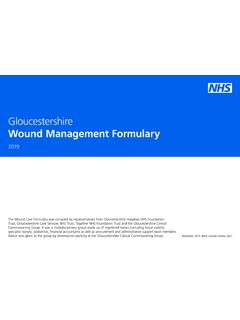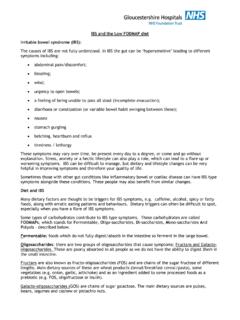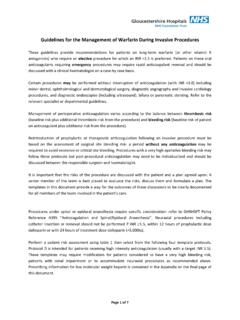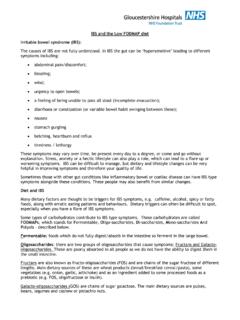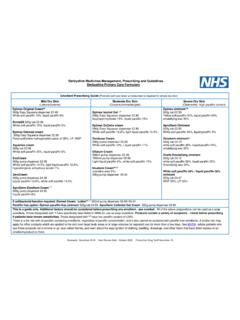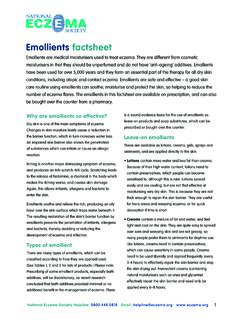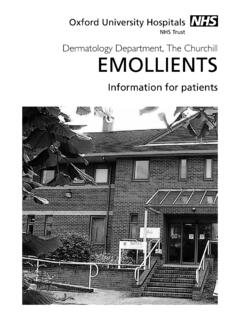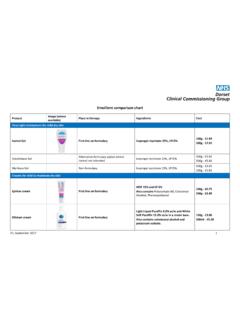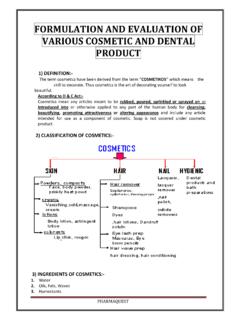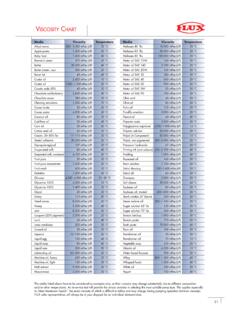Transcription of Emollient Formulary
1 Review date: September 2021 Page 1 of 6 Emollient Formulary MEDIUM EMOLLIENTS Moderate dry skin secondary to a diagnosed dermatological condition Epimax Isomol gel ( liquid paraffin 15%, isopropyl myristate 15%) 100g tube, 500g bottle Zerodouble gel ( liquid paraffin 15%, isopropyl myristate 15%) 100g tube, 500g pump Epimax ExCetra cream ( white soft paraffin , liquid paraffin ) 100g tube, 500g bottle Zerobase cream ( liquid paraffin 11%, white soft paraffin 10%) 100g tube, 500g pump HEAVY EMOLLIENTS Severe dry skin secondary to a diagnosed dermatological condition liquid paraffin / white soft paraffin * ( liquid paraffin 50%, white soft paraffin 50%) 500g tub Epimax ointment* (Yellow soft paraffin 30%, liquid paraffin 40%, emulsifying wax 30%) 125g tub, 500g tub Zeroderm ointment* ( liquid paraffin 40%, white soft paraffin 30%, emulsifying wax 30%) 125g tub, 500g tub SPRAY Emollient Very painful/fragile skin where there is difficulty with application of creams/ointments Emollin spray ( liquid paraffin 50%, white soft paraffin 50%) 150ml, 240ml spray Useful for elderly patients requiring application to back EMOLLIENTS WITH ANTIMICROBIAL Short term use to wash and/or leave on Emollient for skin infection ONLY Dermol 500 lotion ( liquid paraffin , isopropyl myristate , benzalkonium chlor.)
2 , chlorhexidine hydrochlor. ) 500ml pump Dermol cream ( liquid paraffin 10%, isopropyl myristate 10%, benzalkonium chlor. , chlorhexidine hydrochlor. ) 100g tube, 500g pump Eczmol cream (Chlorhexidine gluconate) 250ml bottle *only available in tubs; therefore not suitable for use in residential care settings where tub containers have to be disposed of 28 days after opening which is not cost-effective. LIGHT EMOLLIENTS Mild dry skin secondary to a diagnosed dermatological condition Epimax Original cream ( liquid paraffin 6%, white soft paraffin 15%) 100g tube, 500g bottle ZeroAQS* ( liquid paraffin 6%, white soft paraffin 15%) 500g tub March 2013 MHRA update: AQUEOUS CREAM is no longer recommended due to its sodium lauryl sulphate (SLS) content which can further cause skin drying and irritation. Dec 2018 MHRA update: Warnings about the risk of severe and fatal burns have been extended to all paraffin -based emollients regardless of paraffin concentration.
3 (There may also be a risk for paraffin -free emollients). Patients who use these products should be advised not to smoke or go near naked flames, and be warned about the easy ignition of clothing, bedding, dressings, and other fabrics that have dried residue of an Emollient product on them. Prescribing of emollients is only indicated for a diagnosed dermatological condition. For mild and moderate dry skin, patients should be advised to purchase emollients over the counter (OTC). The prescribing of bath and shower preparations is not supported. Review date: September 2021 Page 2 of 6 EMOLLIENTS WITH UREA Where a keratolytic is required (scaly skin) hyperkeratosis, ichthyosis, extremely dry eczema and psoriasis, or those who have tried other emollients without success. Balneum cream (5% urea) 50g, 500g pump Balneum Plus cream 5% urea (Lauromacrogols 3%, urea 5%) 100g, 500g pump Hydromol intensive cream (10% urea) 30g, 100g tube Flexitol 10% urea cream (urea 10%)150g tube, 500g pump Flexitol Heel balm (urea 25%) 40g tube, 75g tube, 200g tube, 500g tub EMOLLIENTS WITH NO paraffin CONTENT Patients on home oxygen therapy MHRA alert on risk of burns with emollients Aproderm colloidal oat cream (Colloidal oatmeal) 100ml tube, 500ml pump Epimax paraffin free ointment* (Polyoxyethylene hydrogenated castor oil 38%) 500g tub EXCIPIENT-FREE EMOLLIENTS Where there is concern about unknown contact dermatitis liquid paraffin / white soft paraffin * ( liquid paraffin 50%, white soft paraffin 50%) 500g tub Diprobase ointment ( liquid paraffin 5%, white soft paraffin 95%) 50g tube, 500g tub Tube useful for occluded areas ( genitals)
4 For hygiene reasons Emollin spray ( liquid paraffin 50%, white soft paraffin 50%) 150ml, 240ml spray SEVERE ITCHING Without obvious skin disease Dermacool (menthol in aqueous cream) , 1%, 2% 100g tube or tub, 500g pump Ultraveen Itch Relief cream (Colloidal oatmeal 3%, urea 5%) 125ml tube, 500ml pump COST EFFECTIVE EQUIVALENT SWITCHES If there is a good clinical reason why a patient should remain on a less cost-effective option, this should be clearly communicated and recorded in the patient s health record. Oilatum cream ( white soft paraffin 15%, liquid paraffin 6%) Diprobase cream ( liquid paraffin 6%, white soft paraffin 15%, cetomacrogol , cetostearyl alc. ) Epimax Original cream ( white soft paraffin 15%, liquid paraffin 6%) ZeroAQS* ( liquid paraffin 6%, white soft paraffin 15%) Cetraben cream ( white soft paraffin , liquid paraffin ) Epimax ExCetra cream ( white soft paraffin , liquid paraffin ) Doublebase gel ( liquid paraffin 15%, isopropyl myristate 15%) Epimax Isomol gel ( liquid paraffin 15%, isopropyl myristate 15%) Zerodouble gel ( liquid paraffin 15%, isopropyl myristate 15%) Epaderm ointment* (Yellow soft paraffin 30%, liquid paraffin 40%, emulsifying wax 30%) Hydromol ointment* (Yellow soft paraffin 32%, cetomacrogol emulsifying wax , liquid paraffin ) Epimax ointment* (Yellow soft paraffin 30%, liquid paraffin 40%, emulsifying wax 30%) Zeroderm ointment* ( liquid paraffin 40%, white soft paraffin 30%, emulsifying wax 30%) Aveeno cream (Colloidal oatmeal) Epimax Oatmeal cream (Avena sativa (oat) kernel flour) Review date.
5 September 2021 Page 3 of 6 PRESCRIBING GUIDE CHOOSING THE BEST Emollient FOR YOUR PATIENT Points to consider when prescribing emollients There is no evidence from controlled trials to support the use of one Emollient over another, therefore selection is based on the known physiological properties of emollients, patient acceptability, dryness of the skin, area of skin involved and lowest acquisition cost. Patient lifestyle and preference - may prefer light moisturiser during day and greasy one at night. Previous emollients - may have tried other moisturisers with little benefit. Cost - emollients vary greatly in price, therefore use the most cost effective (see page 2 for cost-effective switches) The greasier an Emollient is the more effective it is at retaining hydration. Leave-on emollients should be prescribed in large quantities (250-500g weekly) for severe cases.
6 This encourages improvement in eczema and decreases the amount of topical steroid needed. See page 5 for suitable quantities for prescribing. In general, pump dispensers are preferred to tubs. If using a tub, it is recommended to use a clean spoon to remove the Emollient prior to application. The in-use shelf-life ( once opened) of emollients in tubs may be shorter than those in pump dispensers and tubes. Prescribe the smallest to quantity to avoid wastage. Types of emollients Emollient is defined as a substance whose main action is to occlude the skin surface and to encourage build-up of water within the stratum corneum. Generally the greasier an Emollient is the more effective it is. All should be applied frequently at least twice per day. Lotions Lotions (except Dermol Lotion where an antimicrobial is required) are not generally recommended except for temporary use where folliculitis/occlusion has occurred with creams / ointments.
7 Lotions need reapplying frequently on very dry skin Creams May be more cosmetically acceptable than oil based moisturisers Mixture of water and fat, well absorbed Ointments Oily preparation generally greasy and occlusive No preservatives, less likely to irritate skin than creams or lotions (see page 2 if an excipient-free Emollient is required) Useful for very dry and thickened skin, ideal under wet wraps Review date: September 2021 Page 4 of 6 Bath and shower Preparations Bath oils are not recommended Avoid bubble baths and soaps as they can be irritant Avoid conventional soaps/wash products as these strip the skin of natural oils and cause shedding of skin cells. For washing, use an Emollient as a soap substitute Epimax Original cream (all the emollients, except for white soft paraffin alone, can be used in this way).
8 Emollient soap substitutes do not foam but are just as effective at cleaning the skin as soap. When using emollients as soap substitutes, there is less skin irritation caused by water if the Emollient is applied first and then rinsed off. Encourage to bathe regularly. Functions of the bath routine are to: o Clean the skin preventing infection by removing scales, crusts, dried blood and dirt from the skin. o Moisturise the skin and reduce discomfort caused by dry skin o Hydrate the skin making it more receptive to active topical therapy, topical corticosteroids. If emollients are not tolerated as a soap substitute ( due to lack of foaming), patients may purchase QV Gentle Wash (Glycerol 15%) [250ml bottle, 500ml pump] however such products are not recommended for NHS prescribing as per NHS Clinical Commissioning guidance. Antiseptic/antimicrobial containing emollients There is limited evidence to support use of antiseptic/antimicrobial containing emollients and routine use should be avoided.
9 Their use should be restricted to recurrent infection for limited periods only. In selected cases, where recurrent infection is a contributory factor to relapse, they can play an important role in stabilizing the patient s condition. Review date: September 2021 Page 5 of 6 Quantities of Emollient prescribing in adults A trial of cost-effective emollients suitable for the patient should be prescribed in small packs initially for the patient to decide which is the most suitable for them. A larger quantity then can be considered after this point. For Emollient , general rule is 600g per week. This table suggests suitable quantities to be prescribed for an adult for a minimum of twice daily application for one week. For children approximately half this amount is suitable. Area of application Creams and Ointments (Flare-up) Creams and Ointments Face 50-100g 15-30g Both hands 100-200g 25-50g Scalp 100-200g 50-100g Both arms or both legs 300-500g 100-200g Trunk 1000g 400g Groin and genitalia 50-100g 15-25g Prescribing in children under 12 years Based on clinical experience of hospital dermatologists, greasy based emollients are preferable in children these should be considered after engaging with parents/carers.
10 When prescribing, consideration to suitable quantities should be based on clinical severity and need of patients: Child with severe eczema can use 2 x 500g of Emollient per month. Leave-on emollients should be prescribed in large quantities (250-500g weekly) for severe cases. This encourages improvement in eczema and decreases the amount of topical steroid needed. Ensure adequate quantities for patient are prescribed in primary care, as experience from hospital dermatologist is that families do not use enough emollients. 250g/week is sufficient for total body coverage of a child. GPs should prescribe up to 1000g/month if patient requests and compliance should be checked. Emollients should be easily available to use at nursery, pre-school or school. A greasy Emollient for use at home and a lighter cream at nursery, pre-school or school can aid compliance and improvement. Urea containing emollients These are well suited to the care of large areas of skin even over long periods in patients with atopic eczema.
